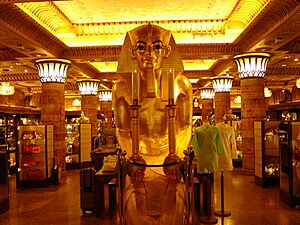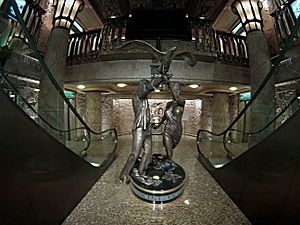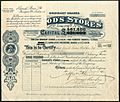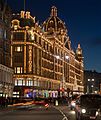Harrods facts for kids
Quick facts for kids Harrods |
|
|---|---|
 |
|

Exterior of Harrods (2007)
|
|
| General information | |
| Status | Open |
| Type | Department store |
| Architectural style | Victorian |
| Location | 87–135 Brompton Road, Knightsbridge, London, England |
| Coordinates | 51°29′59″N 00°09′49″W / 51.49972°N 0.16361°W |
| Named for | Charles Henry Harrod |
| Opened | 1905 |
| Client | Charles Digby Harrod |
| Owner | Harrods Group (Qatar Investment Authority) |
| Technical details | |
| Floor area | 1,100,000 square feet (100,000 m2) of selling space |
| Grounds | 5 acres (20,000 m2) |
| Design and construction | |
| Architect | C. W. Stephens |
| Other information | |
| Number of restaurants | 22 |
|
Listed Building – Grade II*
|
|
| Designated | 15 April 1969 |
| Reference no. | 1294346 |
Harrods is a world-famous luxury department store in the Knightsbridge area of London, England. The huge building, which opened in 1905, is a Grade II* listed building, meaning it is protected for its historical importance.
The store covers 1,100,000 square feet (100,000 m2) of shopping space, making it the largest department store in Europe. With its famous motto, "All Things for All People, Everywhere," Harrods is one of the most well-known stores in the world. It attracts around 15 million visitors every year.
The store was owned by the Harrod family, then by the company House of Fraser, and later by the Al-Fayed family. In 2010, it was sold to the Qatar Investment Authority, the investment fund of the country of Qatar.
Contents
History of Harrods
The Beginning
In 1824, a man named Charles Henry Harrod started his first business in London. He later opened a grocery store in 1834 that specialized in tea. In 1849, he saw an opportunity with the Great Exhibition of 1851, a huge event held in nearby Hyde Park. He took over a small shop on the site where Harrods stands today.
The shop started in a single room with just two assistants and a delivery boy. But Charles's son, Charles Digby Harrod, turned it into a successful business that sold medicines, perfumes, stationery, and food. The store grew quickly, taking over nearby buildings. By 1881, it had one hundred employees.
Fire and Rebirth
In December 1883, a disaster happened: the store burned to the ground. Amazingly, Charles Harrod still managed to deliver all his customers' Christmas orders that year and even made a record profit.
A new, grander building was quickly built on the same spot. The store became so popular that it began to offer credit to its best customers. Famous shoppers included writers like Oscar Wilde and A. A. Milne, actors like Charlie Chaplin, and even members of the British Royal Family.
Famous Toys and an Escalator
Harrods has a special connection to some famous children's stories. Beatrix Potter, the author of The Tale of Peter Rabbit, was a regular visitor. After her book was published in 1902, Harrods began selling the world's first licensed toy character: a Peter Rabbit soft toy.
In 1921, A. A. Milne bought a teddy bear from the store for his son, Christopher Robin Milne. This bear became the inspiration for the famous character Winnie-the-Pooh.
On November 16, 1898, Harrods introduced England's first "moving staircase," which we now call an escalator. It was made of a leather belt with a shiny mahogany and glass railing. Some customers were so nervous about riding it that they were offered a drink of brandy at the top to calm their nerves.
The Store's Design

The store is massive, sitting on a 5-acre (20,000 m2) site. It has over 330 departments, making it the biggest department store in Europe. For comparison, the second-biggest shop in the UK, Selfridges, Oxford Street, is just over half its size.
One of the most famous parts of the store is the Egyptian Escalator. It is decorated in a style inspired by ancient Egypt.
Memorials
After the deaths of Diana, Princess of Wales, and Dodi Fayed, whose father owned Harrods at the time, two memorials were placed inside the store.
The first memorial, from 1998, shows photos of the couple. It also includes a wine glass from Diana's last dinner and a ring Dodi had bought.
The second memorial, called Innocent Victims, is a bronze statue of Diana and Dodi dancing on a beach. It was created by the artist William Mitchell and unveiled in 2005.
What Can You Find at Harrods?
The store's motto is Omnia Omnibus Ubique, which is Latin for "all things for all people, everywhere." This means you can find almost anything inside.
The 330 departments sell a huge variety of items, including:
- Clothing for women, men, and children
- Electronics and toys
- Jewellery and watches
- Sporting equipment
- Pet accessories
- Food and drinks from around the world in the famous Food Halls
- Furniture and items for the home
Harrods also offers many services. There are 23 restaurants, a personal shopping service, a watch repair shop, a spa and salon, and even a service to create custom gift baskets. On its busiest days, the store can have up to 300,000 visitors.
Rules for Shoppers
Dress Code
In 1989, Harrods created a dress code for its customers. People wearing certain items, like swimwear, very short shorts, or dirty clothes, were not allowed in. Even some famous people were turned away for not following the code.
Today, the rules are more relaxed. Harrods states that it does not have a specific dress code, and sportswear is allowed. However, the store can still refuse entry to anyone it feels is not dressed appropriately.
Royal Warrants
For many years, Harrods held royal warrants. These are special seals of approval given to businesses that supply goods to the Royal Family. Harrods had warrants from Queen Elizabeth II, Prince Philip, Duke of Edinburgh, Prince Charles, and Queen Elizabeth, the Queen Mother.
In 2000, the store's owner at the time, Mohamed Al-Fayed, had the warrants removed. He later said that business improved after they were gone.
Important Events
- In 1983, a bombing outside the store by the Provisional IRA killed six people.
- In 1993, another bombing by the IRA injured four people.
Gallery
See also
 In Spanish: Harrods para niños
In Spanish: Harrods para niños
- Fortnum & Mason
- Jenners, a store in Scotland once known as the "Harrods of the North"







